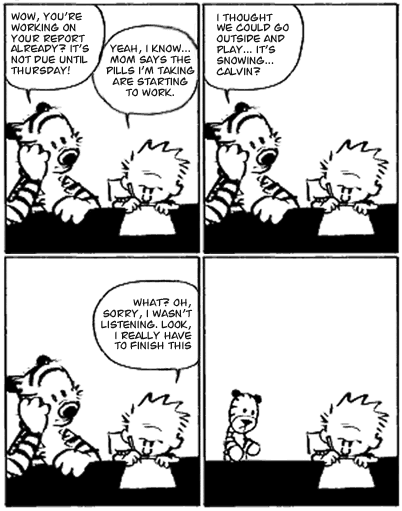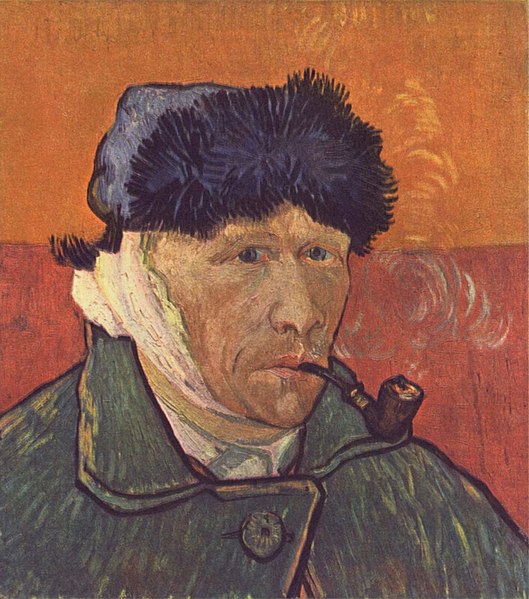
Many of you have seen it before. This infamous (and fake) Calvin and Hobbes strip influenced me when I was first considering taking prozac in high school. That day, during drama club, I had a public breakdown. On the way home, I told my mother and she believed I should see a doctor about medication. This distressed me: I had been influenced by imagery like this, imagery which said my imagination, my creative ability, who I was would be taken away by medication.
Prozac did not do that. What it did do was make me better able to cope with my depression. My breakdowns became more infrequent, I became happier, and combined with treatment my mental health improved. But the influence of that strip stayed with me. Even as much as a few weeks ago, I still had doubts, wondering if my depression were to go away completely, would I still be able to write, to create art?
Why do I think this? Why does a comic like this exist and is so popular and well-known?
In 2011, a study of over one million Swedes attempted to examine a possible link between creativity and mental illness. Here is a summary of their findings:
Except for bipolar disorder, individuals with overall creative professions were not more likely to suffer from investigated psychiatric disorders than controls. However, being an author was specifically associated with increased likelihood of schizophrenia, bipolar disorder, unipolar depression, anxiety disorders, substance abuse, and suicide. In addition, we found an association between creative professions and first-degree relatives of patients with schizophrenia, bipolar disorder, anorexia nervosa, and for siblings of patients with autism.Now consider how these findings were represented in the news. Specifically, consider the headlines.
From the BBC: "Creativity 'closely entwined with mental illness'."
From LiveScience: "Creativity linked to mental illness, study confirms."
While technically true, it is obvious these headlines were trying to go beyond what the study itself said, implying not merely that some artists are more likely to have mental illness or have relatives with mental illness, but that there is a direct link between mental illness and creativity. It's a sentiment that ties in neatly with the popular concept of the tortured artist, or someone whose pursuit of art leads them to mental torment, or whose artistry is caused by their tormented state.
Van Gogh is perhaps the most notorious example of this "tortured artist", who cut off his own ear in pursuit of his art, or so the popular story goes. His "tortured" nature was such that he was believed to have shot himself. Indeed, from Hemingway to Cobain, the artist's suicide has become a trope in itself. No one ever talks about the why of these suicides. There's an implication that such actions are a given. There seems to be some sort of shorthand going on that equates mental illness with improved creative ability, or conversely that artistic pursuit makes one mentally ill.
At first, this seems like a positive revelation. It seems fair that people who struggle with it would be compensated with increased creative ability, and indeed I have used that very reasoning to justify my own mental illness, as though I participated in some trade-off of mental health for creativity. Such reasoning, however, ignores the vast majority of people who struggle with mental illness yet who do not feel inclined towards such artistic professions. If the most this study can say is writers are more likely than the general populace to have mental illness that leaves a large amount of people from the "general populace" with mental illness who are not artists, and thus, gain no advantages from it.
Additionally, this reasoning seems to suggest that it may even be better to maintain mental illness and leave it untreated, because it can bolster one's creativity. Certainly, I used such reasoning in my reluctance to take prozac. Imagine my surprise when, after taking it, I found my creativity had not changed one iota. In fact, my improved mental state made me more willing and able to write, whereas before I would be so stricken with anxiety over writing that I would put it off, again and again.
That is not to say that some medication for mental illness does not have side-effects on some people that is more deleterious than the mental illness themselves. Such cases exist. However, the problem is when these effects are associated not with specific people with specific medication, but with treating all mental illness. It creates the perception that any treatment of mental illness will diminish the person's artistic ability. Treatment is not meant to take away our ability to express ourselves. It is meant to make us better able and equipped to deal with the various challenges of our lives, and by and large, it does this.
Even if mental illness uniformly made the sufferers more creative, and even if treatment of mental illness took away that creativity, it would not be worth it.
Society does not recognize this. Society has built up a cultural system which venerates the art created above the artist, and what the artist did to achieve it. I go to film school. I have seem numerous examples of this. Much praise is heaped upon Alfred Hitchcock for his mastery of the art of cinema, and for the impressive films made in his name. Much less attention is given to how he abused his actresses and ruined their careers in the making of his films. Last Tango in Paris is considered one of Bernardo Bertolucci's best films. The fact that he had his actress raped in the making of the film is regularly glossed over in the praise.
I emphasize this: Regardless of what society says, art is never more important than the person who makes it. Art is meant to be a tool used by people to make their own lives more fulfilling, not a parasite which drains the person in order to improve its own subjective quality. Art for art's sake is a meaningless concept. Art's purpose is not itself. Art's purpose is in the interactions between the art and the creator and the art and the observer, and it is the interaction between art and the creator which matters most. No effect of art is so important as to justify the involuntary suffering of the artist. Art is meant to free us, not imprison us.

No comments:
Post a Comment